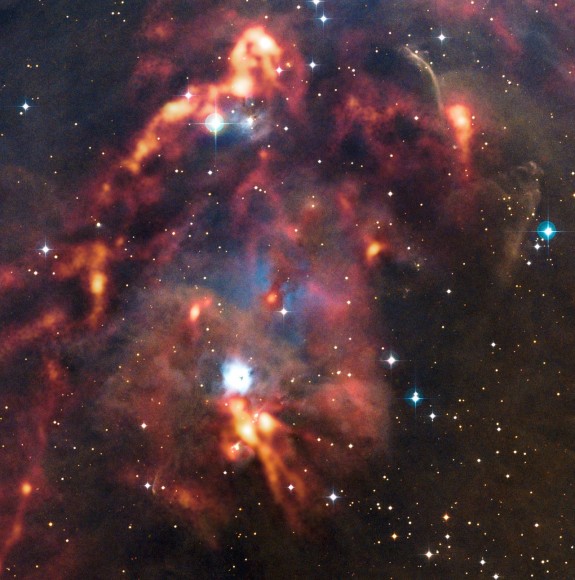Its not looking good for the Aurora Hunters 🙁
NOAA forecasters estimate a 10% chance of M-class solar flares and a mere 1% chance of X-flares today. The probable source would be sunspot AR1660, which is almost directly facing Earth.

Jan 23
Its not looking good for the Aurora Hunters 🙁
NOAA forecasters estimate a 10% chance of M-class solar flares and a mere 1% chance of X-flares today. The probable source would be sunspot AR1660, which is almost directly facing Earth.
Jan 23

When astronomers see dark regions in nebula in visible light, they know there’s something going on. There’s got to be some kind of star forming activity pumping out material that obscures the view to the newly forming starts. Switch to infrared and you can peer through that intervening dust to see the young stars at work.
Astronomers using the European Southern Observatory’s Atacama Pathfinder Experiment (APEX) telescope in Chile were surprised to see a dark region in the nebula NGC 1999, even in infrared, when the cause of the dark region should have been apparent.
Ooo, mystery.
Read more: http://www.universetoday.com/#ixzz2IrQ4OsFR
Jan 22
A new asteroid-mining company will unveil itself to the world on Tuesday (Jan. 22) and is expected to present an ambitious plan to exploit the resources of deep space.
The new private spaceflight company, called Deep Space Industries, Inc., will reveal its plans at 1 p.m. EST (1800 GMT) Tuesday at the Santa Monica Museum of Flying in California. The new company is the second audacious project aimed at tapping the myriad riches that asteroids harbor.
Deep Space seeks to launch “the world’s first fleet of commercial asteroid-prospecting spacecraft,” according to a press advisory the company sent to reporters. “Deep Space is pursuing an aggressive schedule and plans on prospecting, harvesting and processing asteroids for use in space and to benefit Earth.”
The company has revealed few other details thus far. It is led by David Gump, who has been involved in a number of commercial spaceflight ventures. For example, Gump headed up the now-defunct LunaCorp, a privately funded mission that sought to land a rover on the moon.
Deep Space will have some stiff competition in the asteroid-mining business — a firm called Planetary Resources, which had its own unveiling last April.